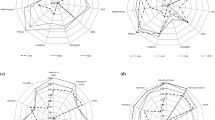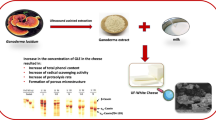Abstract
A very well-known and appreciated mushroom, Agrocybe aegerita (Brig.) Sing, was the subject of chemical profiling, antioxidant assays and sensory evaluation test in cream cheese. Methanolic extract obtained from a wild sample of A. aegerita fruiting body was fully chemically identified. Sample was found to be rich in carbohydrates (84.51 g/100 g dw), ash and proteins (6.69 g/100 g dw and 6.68 g/100 g dw, respectively). Trehalose was the main free sugar while malic acid was the most abundant organic acid. Four isoforms of tocopherols were identified; γ- tocopherol was the dominant isoform with 86.08 μg/100 g dw, followed by β- tocopherol, δ-tocopherol and α-tocopherol (8.80 μg/100 g dw, 3.40 μg/100 g dw and 2.10 μg/100 g dw, respectively). Polyunsaturated fatty acids were predominant, with linoleic acid as the most prominent one (78.40 %). Methanolic extract of chestnut mushroom exhibited high antioxidant activity. Sensory evaluation test included grading by panelists and comparing the overall acceptability of cream cheese alone and enriched cream cheese with dry powder of A. aegerita. General conclusion of the participants was that the newly developed product was more likeable in comparison to cream cheese alone. Due to the health-beneficial effects of antioxidants and wealth of chemically identified nutrients, A. aegerita is a promising starting material for incorporation on larger scale products.
Similar content being viewed by others
References
Altobelli E (2011) Lignicolous fungi with medicinal properties. Sci Acta 5:10–19
Alves MJ, Ferreira ICFR, Dias J, Teixeira V, Martins A, Pintado M (2012) A review on antimicrobial activity of mushroom (Basidiomycetes) extracts and isolated compounds. Planta Med 78:1707–1718
AOAC (1995) Official methods of analysis, 16th edn. Association of Official Analytical Chemists, Arlington
Barros L, Correia DM, Ferreira ICFR, Baptista P, Santos-Buelga C (2008) Optimization of the determination of tocopherols in Agaricus sp. edible mushrooms by a normal phase liquid chromatographic method. Food Chem 110:1046–1050
Barros L, Pereira E, Calhelha RC, Duenas M, Carvalho AM, Santos-Buelga C, Ferreira ICFR (2013) Bioactivity and chemical characterization in hydrophilic and lipophilic compounds of Chenopodium ambrosioides L. J Funct Foods 5:732–1740
Bernas E, Jaworska G, Lisiewska Z (2006) Edible mushrooms as a source of valuable nutritive constituents. Acta Sci Pol 5:5–20
Boh B, Berovic M, Zhang J, Zhi-Bin L (2007) Ganoderma lucidum and its pharmaceutically active compounds. Biotechnol Annu Rev 13:265–301
Brennan MA, Derbyshire E, Tiwari BK, Brennan CS (2012) Extruded snack products with coproducts from chestnut mushroom (Agrocybe aegerita) production: interactions between dietary fiber, physicochemical characteristics and glycemic load. J Agric Food Chem 60:4396–4401
Cámara MM, Díez C, Torija ME, Cano MP (1994) HPLC determination of organic acids in pineapple juices and nectars. Z Lebensm Unters Forsch 198:52–56
Chang ST, Miles P (2004) Mushrooms. Cultivation, nutritional value, medicinal effect, and environmental impact. 2004 2nded CRC Press
Diyabalange T, Mulabagal V, Mills M, DeWit DL, Nair MG (2008) Health-beneficial qualities of the edible mushroom, Agrocybe aegerita. Food Chem 108:97–102
Ergönül PG, Akata I, Kalyoncu F, Ergönül B (2013) Fatty acid compositions of six wild edible mushroom species. Sci World J Article ID 163964
Feng L, Sun H, Zhang Y, Li DF, Da-Cheng W (2010) Structural insights into the recognition mechanism between an antitumor galectin AAL and the Thomsen-Friedenreich antigen. FASEB J 24:3861–3868
Ferreira ICFR, Heleno S, Reis F, Stojkovic D, Queiroz MJRP, Vasconcelos H, Sokovic M (2014) Chemical features of Ganoderma polysaccharides with antioxidant, antitumor and antimicrobial activities. Phytochemistry. doi:10.1016/j.phytochem.2014.10.011
Gao T, Bi H, Ma S, Lu J (2010) The antitumor and immunostimulating activities of water soluble polysaccharides from Radix aconiti, Radix aconiti lateralis and Radix aconiti kusnezoffii. Nat Prod Commun 5:447–455
Heleno SA, Barros L, Sousa MJ, Martins A, Ferreira ICFR (2010) Tocopherols composition of Portugese wild mushrooms with antioxidant capacity. Food Chem 119:1443–1450
Kim WG, Kee LI, Kim JP, Ryoo IJ, Koshino H, Yoo ID (1997) New indole derivatives with free radical scavenging activity from A. cylindracea. J Nat Prod 60:721–723
Lindequist U, Timo J, Julich HW (2005) The pharmacological potential of mushrooms. Evid Based Complement Alternat Med 2:285–299
Lo KM, Cheung PCK (2005) Antioxidant activity of extracts from the fruiting bodies of Agrocybe agerita var. alba. Food Chem 89:533–539
Mshandete AM, Cuff J (2007) Proximate and nutrient composition of three types of indigenous edible wild mushrooms grown in Tanzania and their utilization prospects. Afr J Food Agric Nutr Dev 7:1–6
Ngai PH, Zhao Z, Ng TR (2005) Agrocybin: an antifungal peptide from edible mushroom A. cylindracea. Peptides 26:191–196
Petrovic J, Glamoclija J, Stojkovic D, Nikolic M, Ciric A, Fernades A, Ferreira ICFR, Sokovic M (2014) Bioactive composition, antimicrobial activities and the influence of Agrocybe aegerita (Brig.) Sing on certain quorum-sensing-regulated functions and biofilm formation by Pseudomonas aeruginosa. Food Funct 5:3296–3303
Popović V, Živković J, Davidović S, Stevanović M, Stojković D (2013) Mycotherapy of cancer: an update on cytotoxic and antitumor activities of mushrooms, bioactive principles and molecular mechanisms of their action. Curr Top Med Chem 13:2791–2806
Reis FS, Martins A, Barros L, Ferreira ICFR (2012a) Antioxidant properties and phenolics profile of the most widely appreciated cultivated mushrooms: a comparative study between in vivo and in vitro samples. Food Chem Toxicol 50:1201–1207
Reis FS, Stojković D, Soković M, Glamočlija J, Ćirić A, Barros L, Ferreira ICFR (2012b) Chemical characterization of Agaricus bohusii, antioxidant potential and antifungal preserving properties when incorporated in cream cheese. Food Res Int 48:620–626
Ribeiro B, Valentao P, Baptista RM, Seabra PB (2007) Phenolic compounds, organic acids profiles and antioxidative properties of beefsteak fungus (Fistulina hepatica). Food Chem Toxicol 45:1805–1813
Shuai J, Yijie C, Man W, Yin Y, Pan Y, Gu B, Yu G, Li Y, Wong BHC, Liang Y, Sun H (2012) A novel lectin from Agrocybe aegerita shows high binding selectivity for terminal N-acetyl glucosamine. Biochem J 443:369–378
Simpoulos AP (1999) Essential fatty acids in health and chronic disease. Am J Clin Nutr 70:560S–569S
Stojković D, Reis FS, Barros L, Glamočlija J, Ćirić A, van Griensven LJLD, Soković M, Ferreira ICFR (2013) Nutrients and non-nutrients composition and bioactivity of wild and cultivated Coprinus comatus (O.F.Müll.) Pers. Food Chem Toxicol 59:289–296
Stojković DS, Barros L, Calhelha RC, Glamočlija J, Ćirić A, Van Griensven LJLD, Soković M, Ferreira ICFR (2014) A detailed comparative study between chemical and bioactive properties of Ganoderma lucidum from different origins. Int J Food Sci Nutr 65:42–47
Tadashi K, Sobue S, Ukai S (1994) Polysaccharides in fungi XXXI, structural features of and hypoglycemic activity of two polysaccharides from hot water extracts of Agrocybe cylindracea. Carbohydr Res 251:81–87
Ullrich R, Nüske J, Scheibner K, Spantzel J, Hofrichter M (2004) Novel haloperoxidase from the Agaric Basidiomycete Agrocybe aegerita. Appl Environ Microbiol 70:4575–4581
Valentão P, Lopes G, Valente M, Barbosa P, Andrade PB, Silva BM, Baptista P, Seabra RM (2005) Quantitation of nine organic acids in wild mushrooms. J Agric Food Chem 53:3626–3630
Vaz AJ, Heleno SA, Martins A, Almeida MG, Vasconcelos MH, Ferreira ICFR (2010) Wild mushrooms Clitocybe alexandria and Lepista inversa: In vitro antioxidant activity and growth inhibition of human tumour cell lines. Food Chem Toxicol 48:2881–2884
Wasser SP, Weis AL (1999) Medicinal properties of substances occurring in higher basidiomycetes mushrooms: current perspectives (review). Int J Med Mushrooms 1:31–62
Zhao C, Sun H, Tong X, Qi Y (2003) An antitumour lectin from the edible mushroom Agrocybe aegerita. Biochem J 374:321–327
Acknowledgments
The authors are grateful to the Ministry of Education, Science and Technological Development of Serbia for financial support (grant No. 173032) and to the Foundation for Science and Technology (FCT, Portugal) for financial support to CIMO and Â. Fernandes (SFRH/BD/76019/2011).
Conflict of interest
There is no conflict of interest associated with the authors of this paper.
Author information
Authors and Affiliations
Corresponding authors
Additional information
Research highlights
• Agrocybe aegerita proved to be a rich source of linoleic acid.
• Analysis of the extract showed high content of carbohydrates and proteins.
• Malic acid was the most abundant organic acid and γ-tocopherol was the most abundant isoform.
• Methanolic extract exhibited high antioxidant activity.
• Dried fruiting body proved to be a great enhancer of flavor when incorporated in cream cheese, based on the results of sensory evaluation.
Rights and permissions
About this article
Cite this article
Petrović, J., Glamočlija, J., Stojković, D. et al. Nutritional value, chemical composition, antioxidant activity and enrichment of cream cheese with chestnut mushroom Agrocybe aegerita (Brig.) Sing. J Food Sci Technol 52, 6711–6718 (2015). https://doi.org/10.1007/s13197-015-1783-6
Revised:
Accepted:
Published:
Issue Date:
DOI: https://doi.org/10.1007/s13197-015-1783-6




